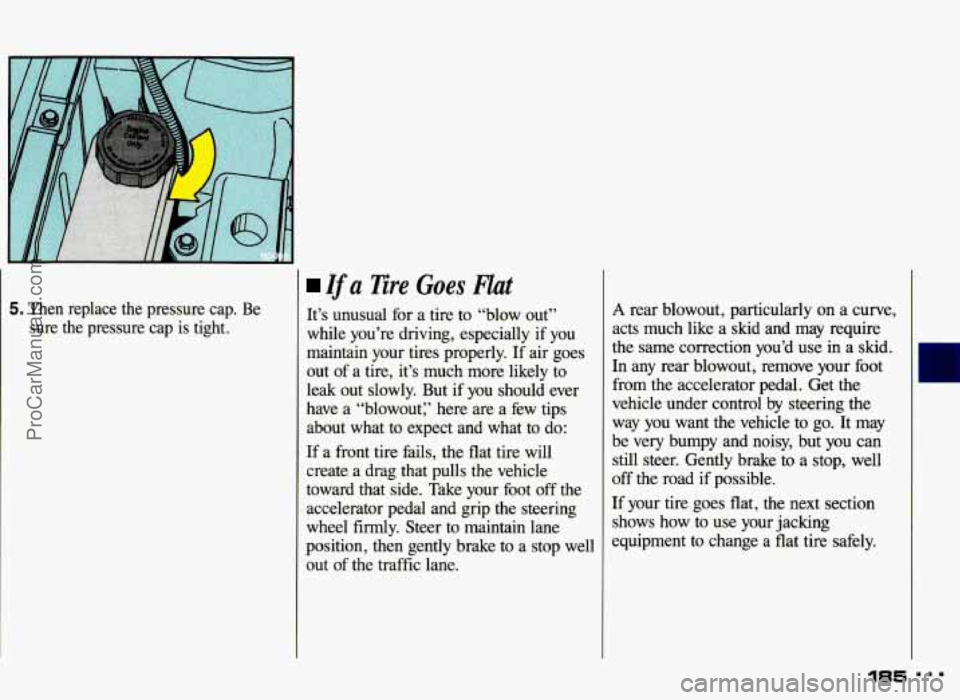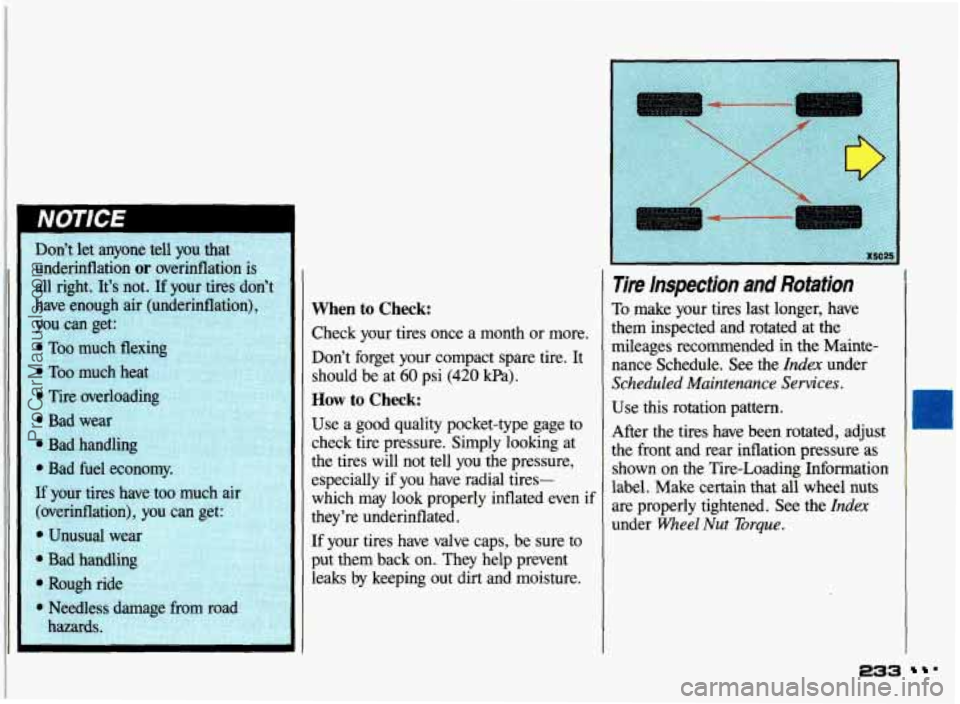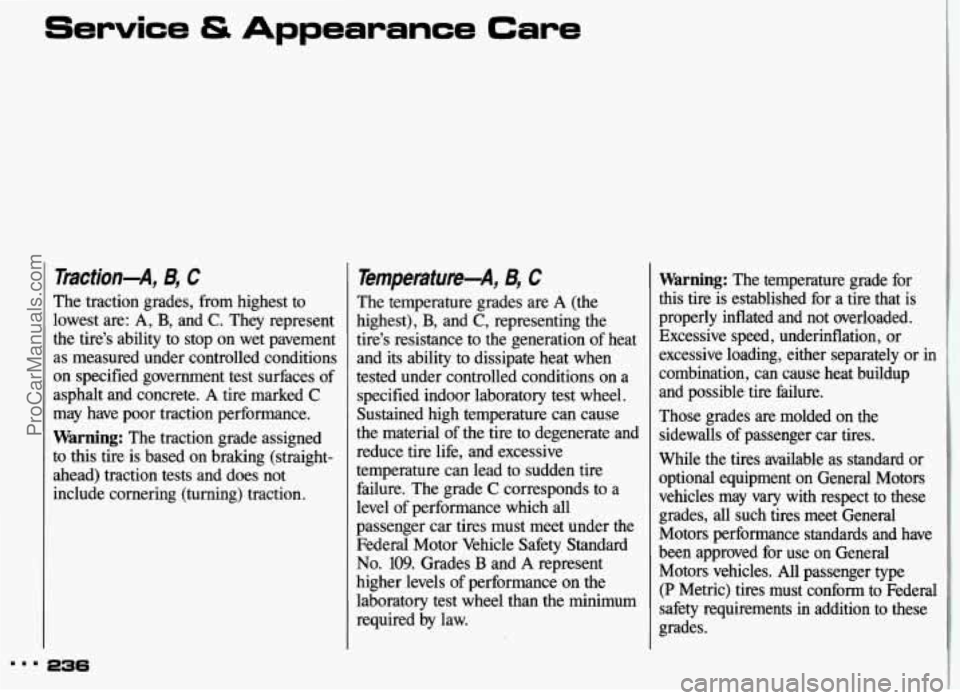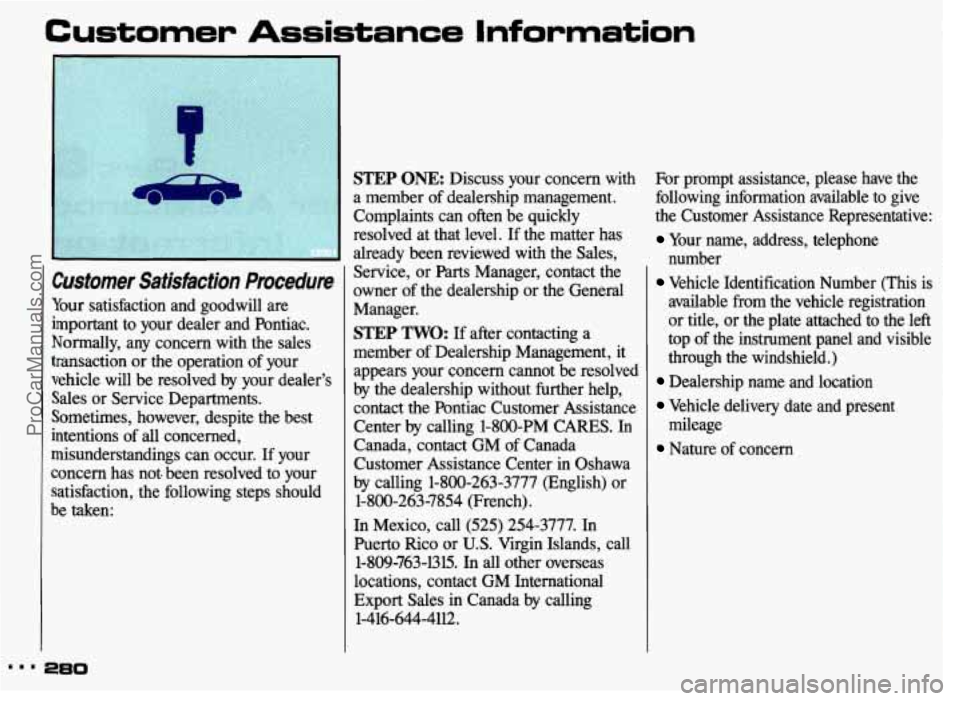1993 PONTIAC GRAND-AM ESP
[x] Cancel search: ESPPage 186 of 306

5. Then replace the pressure cap. Be sure the pressure cap is tight.
Ifa 3iii.e Goes Hat
It’s unusual for a tire to “blow out”
while you’re driving, especially
if you
maintain your tires properly.
If air goes
out of a tire, it’s much more likely to
leak out slowly. But if you should ever
have a “blowout:’ here are
a few tips
about what to expect and what
to do:
If a front tire fails, the flat tire will
create a drag that pulls the vehicle
toward that side. Take your foot
off the
accelerator pedal and grip
the steering
wheel
firmly. Steer to maintain lane
position, then gently brake to a stop well
out of the traffic lane.
A rear blowout, particularly on a curve,
acts much like a skid and may require
the same correction you’d use in a skid.
In any rear blowout, remove your foot
from the accelerator pedal. Get the
vehicle under control by steering the
way
you want the vehicle to go. It may
be very bumpy and noisy, but you can
still steer. Gently brake to a stop, well
off the road
if possible.
If your tire goes flat, the next section
shows how to use your jacking
equipment to change a flat tire safely.
185 I I..
ProCarManuals.com
Page 203 of 306

3
Gasolines for Cleaner Air
Your use of gasoline with detergent
additives will help prevent deposits from
forming in your engine and fuel system.
That helps keep your engine in tune and
your emission control system working
properly. It’s good for your vehicle, and
you’ll be doing your part for cleaner air.
Many gasolines are now blended with
materials called oxygenates. General
Motors recommends that you use
gasolines with these blending materials,
such as MTBE and ethanol. By doing
so, you can help clean the air, especially
in those parts of the country that have
high carbon monoxide levels. In
addition, some gasoline suppliers are
now producing reformulated gasolines.
These gasolines are specially designed
to reduce vehicle emissions. General
Motors recommends that you use
reformulated gasoline. By doing
so, you
can help clean the air, especially in
those parts of the country that have high
ozone levels.
You should ask your service station
operators if their gasolines contain
detergents and oxygenates, and if they
have been reformulated to reduce
vehicle emissions.
Fuels in Foreign Countries
If you plan on driving in another
country outside
the U.S. or Canada,
unleaded fuel may be hard to find.
Do not use leaded gasoline. If you use
even one tankful, your emission controls
won’t work well or at all. With
continuous use, spark plugs can get
fouled, the exhaust system can corrode,
and your engine oil can deteriorate
quickly. Your vehicle’s oxygen sensor
will be damaged. All of that means
costly repairs that wouldn’t be covered
by your warranty.
ProCarManuals.com
Page 218 of 306

the transaxle fluid level if you have been
driving:
When outside temperatures are abve
At high speed for quite a while.
In heavy traffic-especially in hot
While pulling a trailer.
Ta get the right reading, the fluid should
be at normal operating temperature,
which
is 180°F to 200°F (82°C to
93°C).
Get the vehicle warmed up by driving
about 15 miles (24 km) when outside
temperatures are above 50°F (10°C). If
it’s colder
than 50°F (lO°C), you may
have to drive longer.
90°F (32°C).
weather.
0 Park your vehicle an a level place.
Place the shift lever in F (Park) with
With your foot on the brake pedal,
the parking brake applied.
move the shift lever through each gear
range,
pausing for about three seconds
in each range. Then, position the shift
lever
in P (Park).
five minutes.
Let the engine run at idle for three to
Then, Without Shutting OMF the
Engine, Follow These Steps:
1. Pull out the dipstick and wipe it with
a clean rag or paper towel.
2. Push it back in all the way, wait three
seconds and then pull
it back out
again.
3. Check both sides of the dipstick, and
read the luwer level. The fluid level
must be
in the crass-hatched area.
4. If the fluid level is where it should
be, push the dipstick back in all the
way.
ProCarManuals.com
Page 219 of 306

Service & Appearance Care
Automatic Transaxle Fluid (CONT.)
How To Add Fluid:
Refer to the Maintenance Schedule to
determine what kind of transaxle fluid to
use. See the
Index under Fluids &
Lubricants.
If the fluid level is low, add only enough
of the proper fluid to bring the level into
the cross-hatched area on the dipstick.
It doesn’t take much fluid, generally less
than a pint. Don’t overfill. We
recommend you use only fluid
labeled DEXRON@-IIE, because fluids
with that label are made especially for
your automatic transaxle. Damage caused by fluid other than
DEXRON@-IIE is not covered by your
new vehicle warranty.
After adding fluid, recheck the fluid
level as described under
How tu Check.
When the correct fluid level is obtained,
push the dipstick back in all the way.
Manual Transaxle Fluid
When to Check:
A good time to have it checked is when
the engine oil is changed. However, the
fluid in your manual transaxle doesn’t
require changing.
How to Check:
Because this operation can be a little
difficult, you may choose to have this
done at a Pontiac dealership Service
Department.
If you do it yourself, be sure to follow
all the instructions here, or you could
get a false reading on the dipstick.
m.. 218
ProCarManuals.com
Page 234 of 306

When to Check:
Check your tires once a month or more.
Don’t forget your compact spare tire. It
should be at
60 psi (420 kPa).
How to Check:
Use a good quality pocket-type gage to
check tire pressure. Simply looking at
the tires will not tell you the pressure,
especially if you have radial tires-
which may look properly inflated even if
they’re underinflated.
If your tires have valve caps, be sure to
put them back on. They help prevent
leaks by keeping out dirt and moisture.
lire inspection and Rotation
To make your tires last longer, have
them inspected and rotated at the
mileages recommended
in the Mainte-
nance Schedule. See the
Index under
Scheduled Maintenance Sewices .
Use this rotation pattern.
After the tires have been rotated, adjust
the front and rear inflation pressure as
shown
on the Tire-Loading Infomation
label. Make certain that all wheel
nuts
are properly tightened. See the Index
under Wheel Nut Torque.
233 .
ProCarManuals.com
Page 237 of 306

Traction-A, B, C
The traction grades, from highest to
lowest are:
A, B, and C. They represent
the tire’s ability to stop on wet pavement
as measured under controlled conditions
on specified government test surfaces of
asphalt and concrete.
A tire marked C
may have poor traction performance.
Warning: The traction grade assigned
to this tire is based on braking (straight-
ahead) traction tests and does not
include cornering (turning) traction.
Temperature-A, B, C
The temperature grades are A (the
highest),
B, and C, representing the
tire’s resistance to the generation of heat
and its ability to dissipate heat when
tested under controlled conditions on a
specified indoor laboratory test wheel.
Sustained high temperature can cause
the material of the tire to degenerate and
reduce tire life, and excessive
temperature can lead to sudden tire
failure. The grade
C corresponds to a
level of performance which all
passenger car tires must meet under the
Federal Motor Vehicle Safety Standard
No. 109. Grades B and A represent
higher levels of performance on the
laboratory test wheel than the minimum required by law.
Warning: The temperature grade for
this tire is established for a tire that is
properly inflated and not overloaded. Excessive speed, underinflation, or
excessive loading, either separately or in
combination, can cause heat buildup
and possible tire failure.
Those grades are molded on the sidewalls of passenger car tires.
While the tires available as standard or
optional equipment on General Motors
vehicles may vary with respect to these
grades,
all such tires meet General
Motors performance standards and have
been approved for use on General Motors vehicles. All passenger type
(P Metric) tires must conform to Federal
safety requirements in addition to these
grades.
ProCarManuals.com
Page 279 of 306

Maintenance Schedule
Section E: M-aintenance Record
After the scheduled services are performed, record the date, I or Schedule II maintenance charts which correspond to the
odometer reading and who performed the service in the maintenance performed. Also,
you should retain all
columns indicated. When completing the Maintenance maintenance receipts.
Your owner information portfolio is a
Performed column, insert the numbers from the Schedule convenient place to store
them.
ProCarManuals.com
Page 281 of 306

Customer Assistance Information
Customer Satisfaction Procedure
Your satisfaction and goodwill are
important to your dealer and Pontiac.
Normally, any concern with the sales
transaction or the operation of your
vehicle will be resolved by your dealer’s
Sales or Service Departments.
Sometimes, however, despite the best
intentions of all concerned,
misunderstandings can occur. If your
concern has not. been resolved to your
satisfaction, the following steps should
be taken:
STEP ONE: Discuss your concern with
a member of dealership management.
Complaints can often be quickly
resolved at that level.
If the matter has
already been reviewed with the Sales,
Service, or Parts Manager, contact the
owner
of the dealership or the General
Manager.
STEP TWO: If after contacting a
member
of Dealership Management, it
appears your concern cannot be resolved
by the dealership without further help,
contact the Pontiac Customer Assistance
Center by calling 1-800-PM CARES.
In
Canada, contact GM of Canada
Customer Assistance Center in Oshawa
by calling 1-800-263-3777 (English) or
1-800-263-7854 (French).
In Mexico, call (525) 254-3777. In
Puerto Rico or
U.S. Virgin Islands, call
1-809-763-1315. In all other overseas
locations, contact GM International
Export Sales in Canada by calling
1-416-644-4112. For prompt assistance, please have the
following information available to give
the Customer Assistance Representative:
Your name, address, telephone
number
Vehicle Identification Number (This is
available from the vehicle registration
or title, or the plate attached to the left
top of the instrument panel and visible
through the windshield.)
Dealership name and location
Vehicle delivery date and present
Nature of concern
mileage
ProCarManuals.com